ATi Radeon 9600XT Review
ATi Radeon 9600XT
The Canadian work ethic continues with yet another new graphics card from ATi landing in the TrustedReviews office. The Radeon 9600XT is aimed at the budget conscious performance hungry user, and it looks like ATi has got the balance of price, performance and features just right.
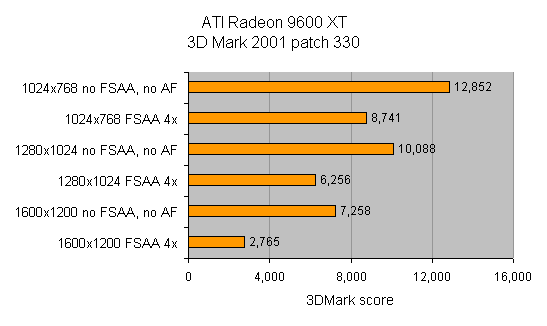
Verdict
Pros
- Full-featured
- Easy-to-use
Cons
- Transfer speeds could be faster
Key Specifications
- Review Price: £176.00
Now this is getting silly. It seems that a week doesn’t pass without a new ATi graphics card arriving at the TrustedReviews offices. Of course I’m not complaining about this, after all it’s a lot better than the kind of technology droughts I’ve seen in the past. But you do have to ask yourself how much sleep the poor old engineers at ATi are getting.
So, the Radeon 9800XT may be the fastest graphics solution you can buy at the moment, but for many users it’s too expensive to be a real contender for their PC graphics solution. Now ATi isn’t blind to this fact and has consequently produced the Radeon 9600XT to address the mainstream market.
Amazingly, the technology behind the 9600XT is more advanced than the 9800XT despite the huge price differential. With the 9600XT ATi has enhanced it’s 0.13 micron process with the inclusion of low-k dielectric technology.
The problem with all chip based products is that the smaller you shrink them, the higher the chance of interference and cross-talk between circuits. When this type of interference is encountered more power is required to maintain efficient transistor switching. Of course the more power a chip draws the more heat it generates resulting in a whole new set of problems.
Using low-k dielectrics improves circuit insulation and thus reduces the amount of cross-talk and interference. This means that the chip has to draw less power and will then radiate less heat.
It’s this reduction in power draw and consequent heat that has allowed ATi to increase the clock speed of the VPU by an impressive 100MHz. The standard Radeon 9600Pro VPU is clocked at 400MHz while the 9600XT ticks over at 500MHz with enough headroom to be pushed a little further.
There’s 128MB of memory on board running at 300MHz (600MHz effective). This is slightly slower than the recently released Radeon 9600Pro All-in-Wonder which runs its memory at 325MHz (650MHz effective), but of course the VPU on the All-in-Wonder is only running at 400MHz. There are no heatsinks on the memory chips, again testament to the low heat generation of the card.
Like the Radeon 9800XT, the 9600XT has a built-in temperature monitor which is designed to work in conjunction with ATi’s Overdrive utility. The Overdrive utility will enable dynamic overclocking of the chip dependant on the ambient temperature of the PC. This means that if the cooling in your PC is up to scratch the speed of the VPU will increase, but if the ambient temperature is too high it won’t. This makes it not only easy to overclock the card and get the most out of it, but it’s also safe.
Another neat trick that ATi has up its sleeve is the VPU recovery utility. This means that if there is a problem with the VPU not communicating with the driver software, the whole system will not crash as is usually the case. Instead the VPU recovery utility will detect when the communication between the VPU and driver stops and attempt to reset the graphics hardware independently. If it’s impossible to reset the graphics hardware the system will be set to a software rendering state, enabling the user to close all open applications and save any work that would otherwise have been lost.
The board itself looks pretty standard and unlike the 9800XT doesn’t require any external power. The backing plate sports both DVI and D-SUB connectors, as well as an S-Video output.
Performance wise the 9600XT is noticeably faster than the 9600Pro All-in-Wonder in our benchmarks, which itself runs slightly faster than a standard 9600Pro. Whether or not you’d actually see much difference in performance in real world use is debatable. What is definite though, is that the 9600XT is more than fast enough to deal with today’s batch of games, as long as you’re not going to bump the resolution up to anything silly.
Talking of games, one of the best features of the Radeon 9600XT is that Half Life 2 will be bundled in the box. Well, not exactly in the box. It’s more likely to be a voucher that entitles you to a copy of Half Life 2, but it will be the full retail version (although without the multiplayer pack). It’s a shame that you won’t be able to open the box, install the card and load Half Life 2, but as I’m sure most of you will know, the release date for the game has slipped and you can choose the reason for this from any number of stories currently circulating around the web.
What can’t be ignored though is that a game like Half Life 2 free with a graphics card adds a lot of value to the package. The retail price of the game is £39.99, so that’s not an insignificant saving if you were planning to buy it anyway.
So, with the Radeon 9800 family battling it out in the high-performance arena, the Radeon 9600XT has to offer it’s plethora of new features at a reasonable price, and thankfully it does just that.
The projected price of the Radeon 9600XT is around £176, which, it has to be said, is pretty amazing. However, when you also take into account the fact that you’re getting a brand new game worth £39.99 free with the card, the price becomes nothing short of staggering.
”’Verdict”’
The Radeon 9600XT is going to be a huge success for ATi. The performance is solid, it has the ability to be safely overclocked, you get one of the most eagerly awaited games of all time free and the price is pretty much a steal. For anyone who wants to upgrade their graphics solution at a reasonable price, look no further.
(table:features)

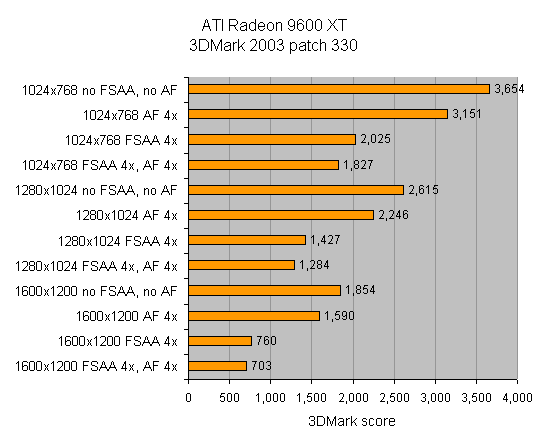
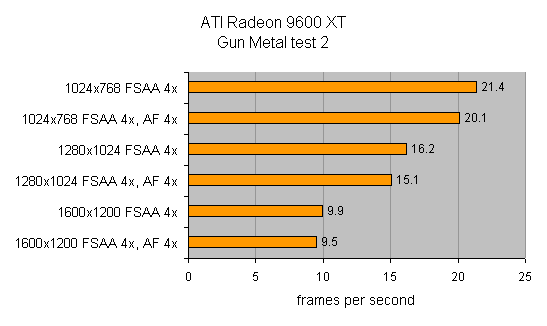
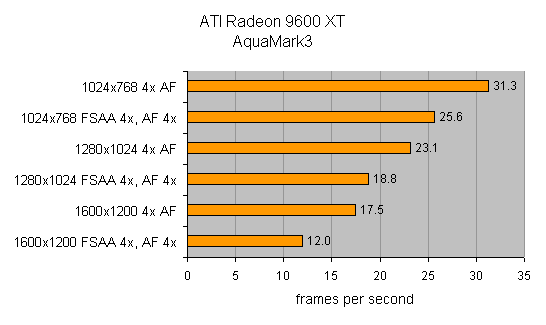
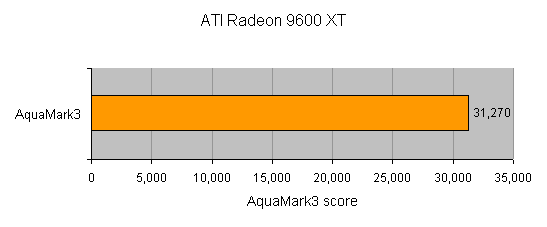
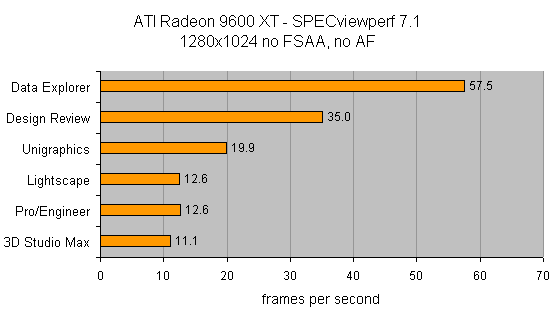
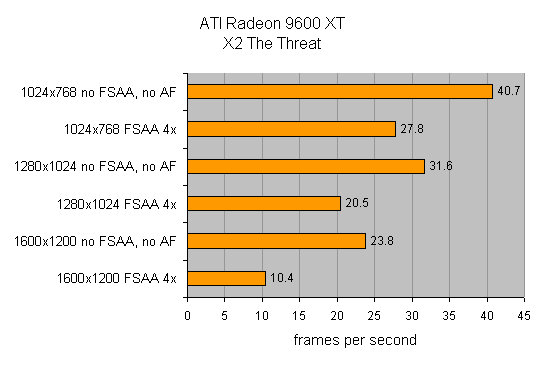
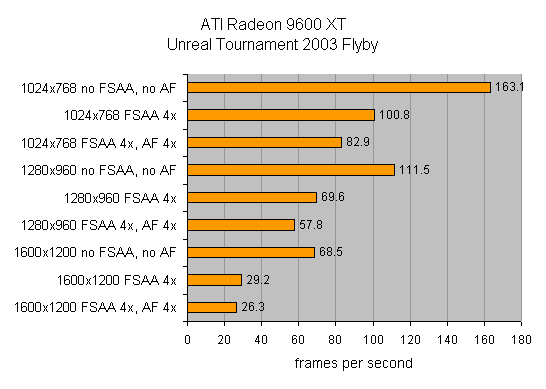
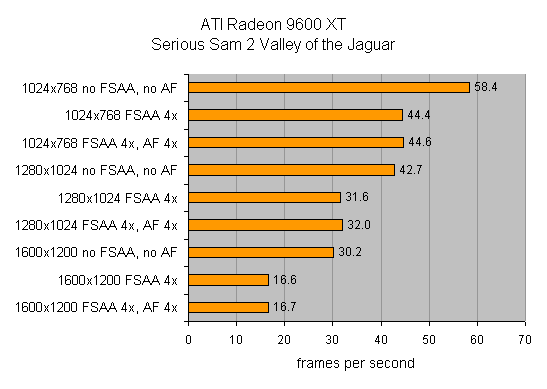
Trusted Score
Score in detail
-
Value 10
-
Features 9
-
Performance 7

